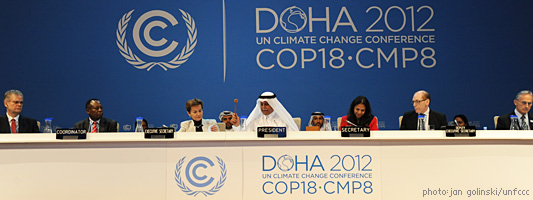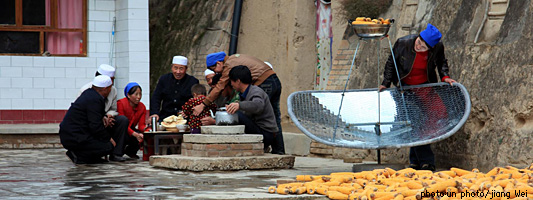The Kyoto Protocol was adopted on 11 December 1997. Owing to a complex ratification process, it entered into force on 16 February 2005. Currently, there are 192 Parties to the Kyoto Protocol.
In short, the Kyoto Protocol operationalizes the United Nations Framework Convention on Climate Change by committing industrialized countries and economies in transition to limit and reduce greenhouse gases (GHG) emissions in accordance with agreed individual targets. The Convention itself only asks those countries to adopt policies and measures on mitigation and to report periodically.
The Kyoto Protocol is based on the principles and provisions of the Convention and follows its annex-based structure. It only binds developed countries, and places a heavier burden on them under the principle of “common but differentiated responsibility and respective capabilities”, because it recognizes that they are largely responsible for the current high levels of GHG emissions in the atmosphere.
In its Annex B, the Kyoto Protocol sets binding emission reduction targets for 37 industrialized countries and economies in transition and the European Union. Overall, these targets add up to an average 5 per cent emission reduction compared to 1990 levels over the five year period 2008–2012 (the first commitment period).
The authoritative information on the status of approval, acceptance, accession and ratification of the the Kyoto Protocol and its amendments is provided by the Secretary-General of the United Nations, on the respective internet page of the United Nations Treaty Depositary under:
Kyoto Protocol to the United Nations Framework Convention on Climate Change
Nairobi Amendment to Annex B of the Kyoto Protocol
Doha Amendment to the Kyoto Protocol
Doha Amendment
In Doha, Qatar, on 8 December 2012, the Doha Amendment to the Kyoto Protocol was adopted for a second commitment period, starting in 2013 and lasting until 2020.
As of 28 October 2020, 147 Parties deposited their instrument of acceptance, therefore the threshold of 144 instruments of acceptance for entry into force of the Doha Amendment was achieved. The amendment entered into force on 31 December 2020.
The amendment includes:
- New commitments for Annex I Parties to the Kyoto Protocol who agreed to take on commitments in a second commitment period from 1 January 2013 to 31 December 2020;
- A revised list of GHG to be reported on by Parties in the second commitment period; and
- Amendments to several articles of the Kyoto Protocol which specifically referenced issues pertaining to the first commitment period and which needed to be updated for the second commitment period.
On 21 December 2012, the amendment was circulated by the Secretary-General of the United Nations, acting in his capacity as Depositary, to all Parties to the Kyoto Protocol in accordance with Articles 20 and 21 of the Protocol.
During the first commitment period, 37 industrialized countries and economies in transition and the European Community committed to reduce GHG emissions to an average of five percent against 1990 levels. During the second commitment period, Parties committed to reduce GHG emissions by at least 18 percent below 1990 levels in the eight-year period from 2013 to 2020; however, the composition of Parties in the second commitment period is different from the first.
The Kyoto mechanisms
One important element of the Kyoto Protocol was the establishment of flexible market mechanisms, which are based on the trade of emissions permits. Under the Protocol, countries must meet their targets primarily through national measures. However, the Protocol also offers them an additional means to meet their targets by way of three market-based mechanisms:
These mechanisms ideally encourage GHG abatement to start where it is most cost-effective, for example, in the developing world. It does not matter where emissions are reduced, as long as they are removed from the atmosphere. This has the parallel benefits of stimulating green investment in developing countries and including the private sector in this endeavour to cut and hold steady GHG emissions at a safe level. It also makes leap-frogging—that is, the possibility of skipping the use of older, dirtier technology for newer, cleaner infrastructure and systems, with obvious longer-term benefits—more economical.
Monitoring emission targets
The Kyoto Protocol also established a rigorous monitoring, review and verification system, as well as a compliance system to ensure transparency and hold Parties to account. Under the Protocol, countries' actual emissions have to be monitored and precise records have to be kept of the trades carried out.
Registry systems track and record transactions by Parties under the mechanisms. The UN Climate Change Secretariat, based in Bonn, Germany, keeps an international transaction log to verify that transactions are consistent with the rules of the Protocol.
Reporting is done by Parties by submitting annual emission inventories and national reports under the Protocol at regular intervals.
A compliance system ensures that Parties are meeting their commitments and helps them to meet their commitments if they have problems doing so.
Adaptation
The Kyoto Protocol, like the Convention, is also designed to assist countries in adapting to the adverse effects of climate change. It facilitates the development and deployment of technologies that can help increase resilience to the impacts of climate change.
The Adaptation Fund was established to finance adaptation projects and programmes in developing countries that are Parties to the Kyoto Protocol. In the first commitment period, the Fund was financed mainly with a share of proceeds from CDM project activities. In Doha, in 2012, it was decided that for the second commitment period, international emissions trading and joint implementation would also provide the Adaptation Fund with a 2 percent share of proceeds.



